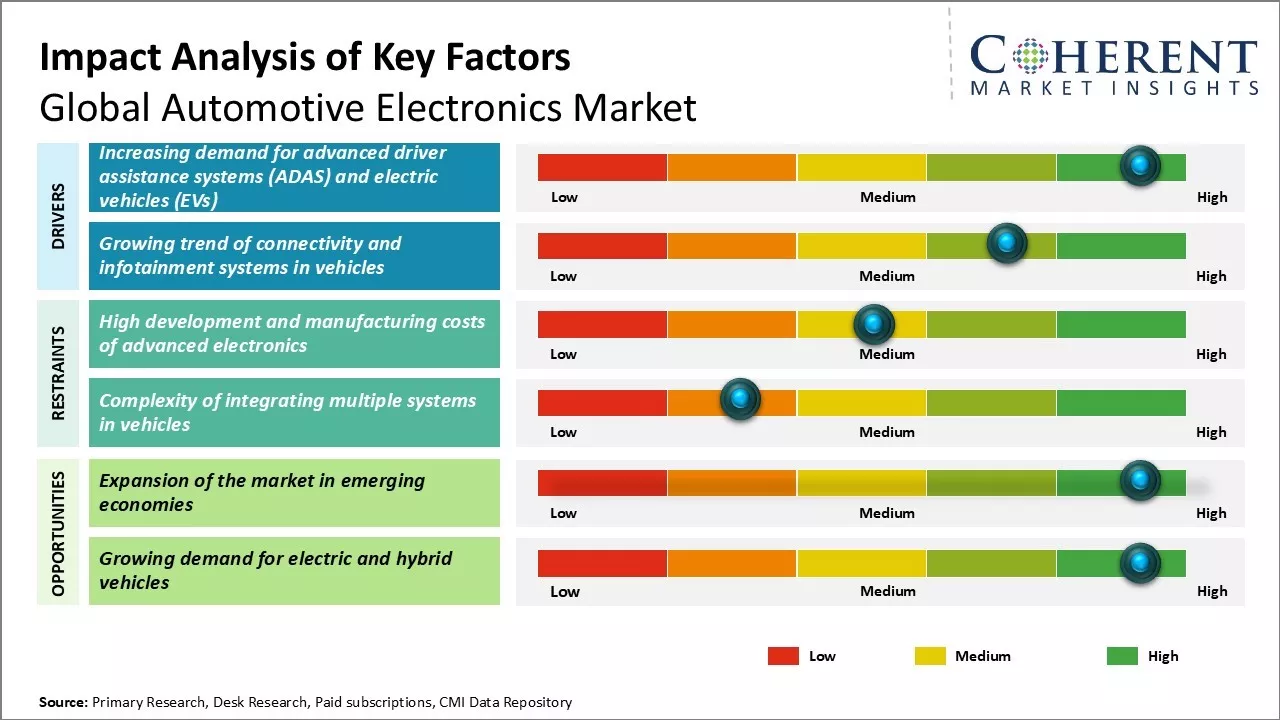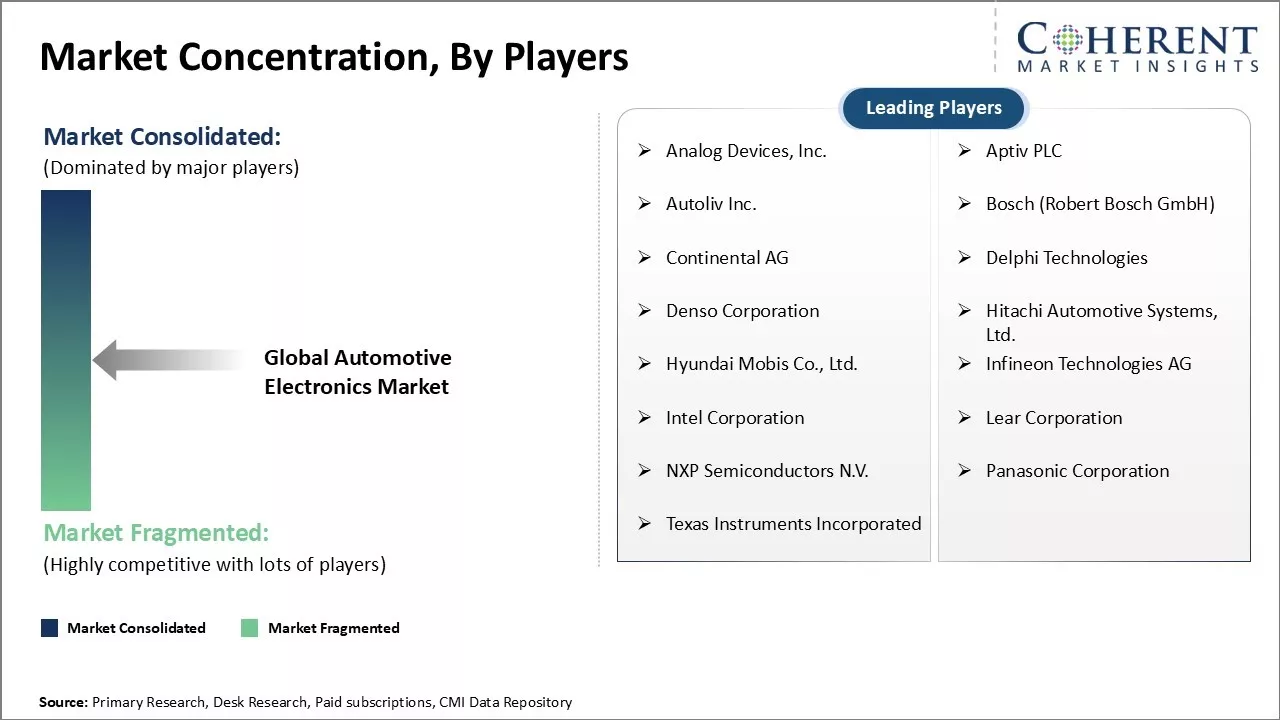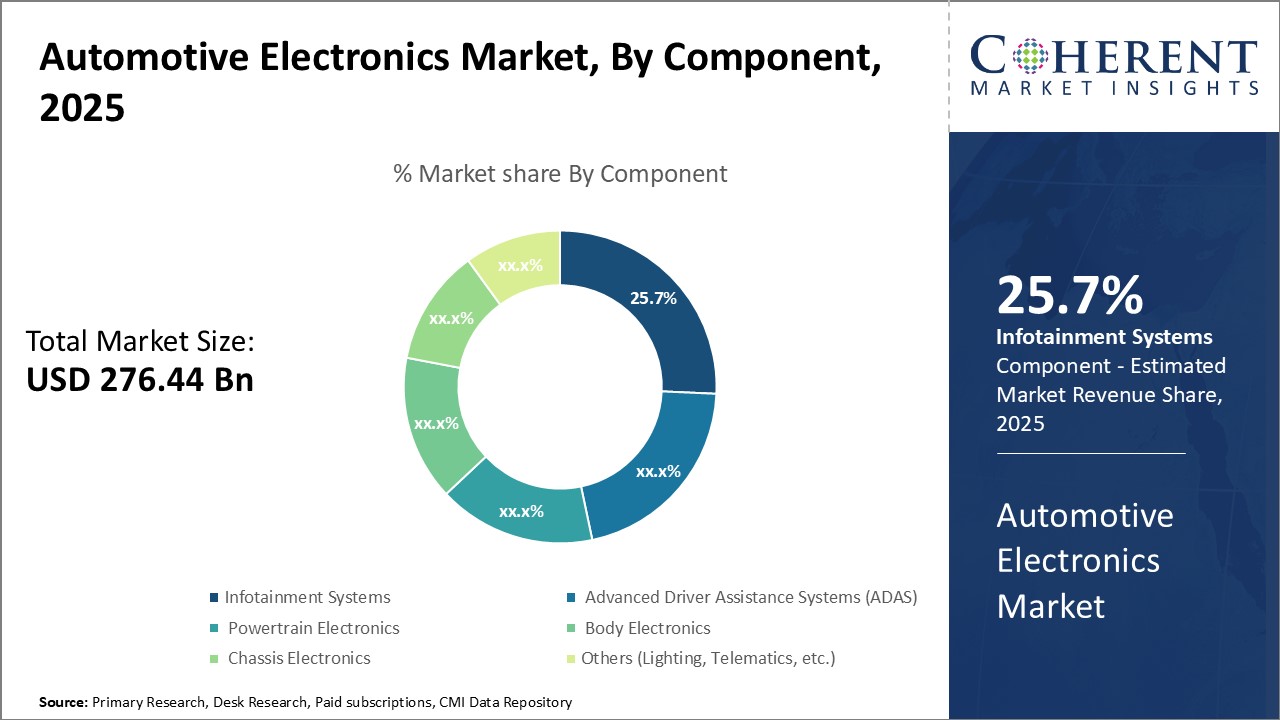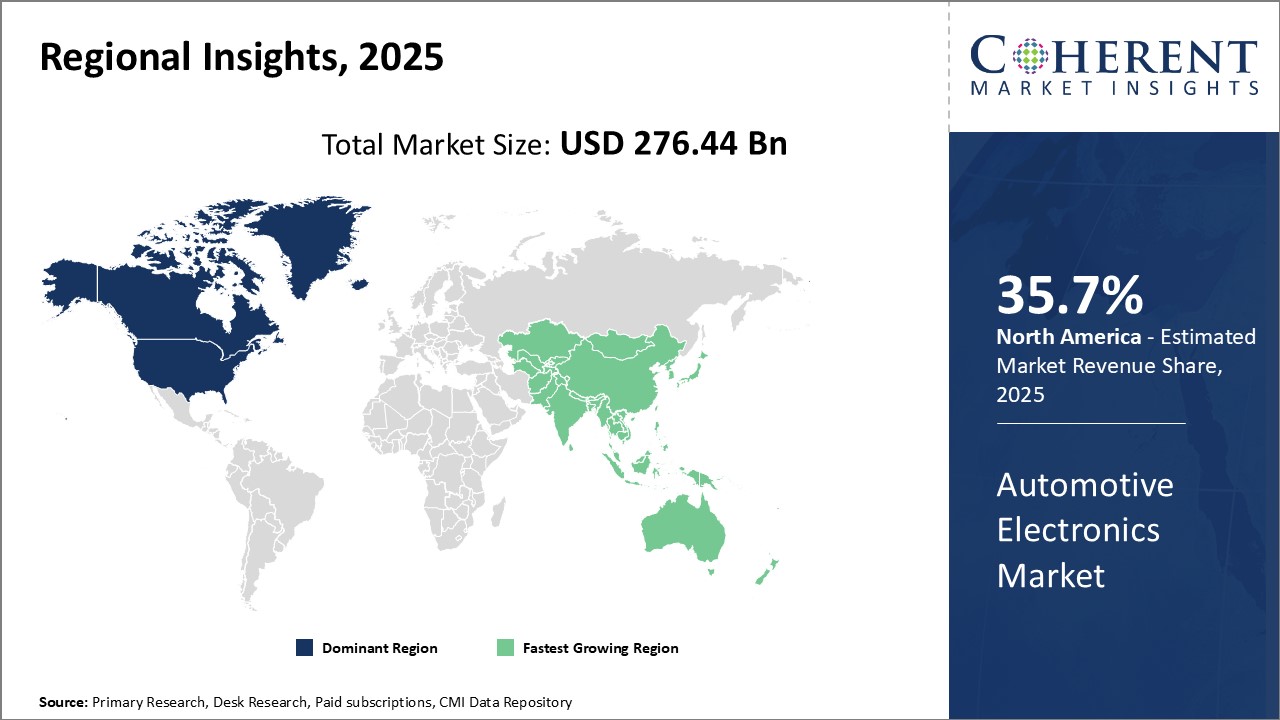Global automotive electronics market is estimated to be valued at USD 276.44 Bn in 2025 and is expected to reach USD 489.65 Bn by 2032, exhibiting a compound annual growth rate (CAGR) of 8.5% from 2025 to 2032.

Discover market dynamics shaping the industry: Request sample copy
Rising demand for advanced safety, infotainment, and comfort features from consumers can drive the automotive electronics market growth. Technologies such as advanced driver assistance systems (ADAS), autonomous driving, connected cars, and car-to-car communication can witness huge demand due to increasing focus of automakers on safety and connectivity.
Market Driver - Increasing demand for advanced driver assistance systems (ADAS) and electric vehicles (EVs)
The automotive industry has witnessed huge demand for vehicles equipped with advanced driver assistance systems and technologies that enhance vehicle and road safety. ADAS technologies like adaptive cruise control, lane departure warning, automatic emergency braking, blind spot monitoring, and park assist are becoming increasingly popular among consumers. Automakers are also proactively making these systems a standard feature in many new vehicles recognizing their importance. With advancements in technologies like radar, ultrasonic sensors, cameras, and computer vision, ADAS systems can now provide drivers with active assistance and automated features that take some control tasks away from the driver and make driving safer.
Electric vehicles are also transforming the automotive landscape, supported by government policies and regulations to curb vehicle emissions. There has been huge demand for electric passenger cars, and all major automakers now have ambitious EV production targets and product launch plans to switch a part of their fleet to electric. As battery technologies improve and costs decline, there will be increase in driving range of EVs that can help to overcome consumer range anxiety. The rapid expansion of public charging networks across cities and major highways is further incentivizing consumers to choose electric vehicles. Automakers are pouring billions into electrification of their lineups and development of advanced batteries, powertrains, and vehicle electronics that power EVs. This boosts automotive electronics industry as electronic components become more critical in electric vehicles.

Get actionable strategies to beat competition: Request sample copy
Growing Trend of Connectivity and Infotainment Systems in Vehicles
Vehicles are increasingly becoming mobile networking devices and there has been huge demand for advanced connectivity and digital capabilities from drivers and passengers. Technologies like embedded telematics control units, multimedia, and navigation systems, and smartphones integrations that allow features like in-vehicle apps witnesses widespread adoption. Consumers want to be constantly connected even while driving and access entertainment, information and productivity features seamlessly within their vehicles. This has pushed automakers to equip even basic trim level vehicles with touchscreen infotainment systems, advanced connectivity features like wifi hotspots, advanced speech recognition and connectivity options like Apple CarPlay and Android Auto. Cloud-based technologies are also enhancing vehicle-to-vehicle and vehicle-to-infrastructure communication capabilities. With high-speed in-vehicle data networks automotive electronics are allowing safer, more informative and seamless driving experience through growth of connected services. The rise of mobility-as-a-service business models and autonomous driving trials can boost integration of advanced digital capabilities in vehicles. Connectivity and always-on vehicle infotainment systems are becoming significantly important purchasing considerations for consumers.
Key Takeaways from Analyst:
Global automotive electronics market growth is driven by increasing demand for advanced safety, infotainment and comfort features in vehicles. Technologies such as adaptive cruise control, parking assistance systems, navigation systems, and connectivity solutions are becoming more common even in mass market vehicles. This trend towards vehicle electrification and automation can drive the market growth. However, high research and development costs involved in developing new electronics for emerging mobility solutions can hamper the market growth.
North America currently dominates the global automotive electronics market, owing to robust demand for luxury vehicles with the latest infotainment and driver assistance technologies. However, Asia Pacific region is expected to be the fastest growing market due to rising production and sales of passenger cars in major economies like China and India. Within Asia Pacific, China offers lucrative opportunities for automotive electronics suppliers as the market growth is driven by the country's push for new energy vehicles.
On the connectivity front, over-the-air firmware updates allow automakers to continuously optimize vehicle performance and offer new feature upgrades to enhance the driver experience. This trend opens up opportunities for car electronics vendors to provide premium after-sales services. There is also potential to leverage connected car data through big data analytics, which can help automakers improve future vehicle designs.
Market Challenge - High development and manufacturing costs of advanced electronics
High development and manufacturing costs associated with advanced automotive can hamper the global automotive electronics market growth. Developing cutting-edge technologies such as advanced driver assistance systems, infotainment units, telematics solutions, and other electronics requires huge investments in research and development. Manufacturing such complex electronic components and systems involves high production costs due to the usage of premium components and stringent quality control measures. These elevated costs are further increased by constraints in economies of scale during the early phases of new technologies. While automakers aim to pass on some of these additional expenses to customers, it also makes such advanced vehicles out of reach for many buyers. The high costs of electronics can act as a barrier for mass adoption and widespread use of the latest automotive technologies.
Market Opportunity: Expansion of the market in emerging economies
The expansion of global automotive electronics market in emerging economies provides tremendous growth opportunities. As developing countries like China, India, Indonesia and others witness rising middle class and increasing disposable incomes, there has been huge demand for vehicles. However, most markets in emerging nations are still in the early expansion stage with large potential to grow further in the near future. This provides automotive electronics manufacturers an opportunity to enter these markets with customized offerings suitably priced for customers in price-sensitive developing countries. The establishment of local manufacturing facilities could also help lower costs and boost market penetration. Emerging markets offer a platform to test and refine new products before rolling them out on a larger scale globally. Therefore, tapping into the large untapped markets in developing economies can drive significant revenues for automotive electronics companies in the future.

Discover high revenue pocket segments and roadmap to it: Request sample copy
Insights By Component - Technology evolution boosts adoption of infotainment systems
In terms of component, infotainment systems segment is estimated to contribute the highest market share of 25.7% in 2025, owing to rapid technological advancement in connectivity and multimedia entertainment solutions for automobiles. Vehicles are increasingly becoming mobile connectivity hubs with sophisticated infotainment systems that integrate smartphones, onboard applications and cloud services. Automakers are recognizing that in-car entertainment and communication technology helps enhance the driving experience for consumers and strengthen brand value. Thus, automakers are investing heavily in developing advanced infotainment platforms that offer seamless integration of functions like navigation, audio/video playback, app store compatibility and rear seat displays. The consumer preference for connectivity on- the- move along with availability of cheaper components propel car buyers to opt for well-equipped infotainment packages. With internet access in vehicles becoming commonplace, the scope of in-dash applications is continuously expanding to include real-time traffic updates, points-of-interest data, advanced telematics and software over-the-air updates. Such improvements in functionality as well as the trend of new cars arriving with standard infotainment units have boosted infotainment systems adoption rates in all vehicles. As technical progress in connectivity, display, storage, and interface technologies enables richer in-cabin experiences, the infotainment systems segment is expected to witness growth.
Insights By Vehicle Type - Passenger vehicle proliferation boosts electronics adoption
In terms of vehicle type, passenger cars segment is estimated to contribute the highest market share of 54.6% in 2025, owing to the sheer volumes in which these are produced worldwide. Sedans, SUVs, coupes and other commercial passenger vehicle models together dominate global vehicle sales. As personal mobility becomes an integral part of modern lifestyles, rising incomes especially in developing nations facilitates car ownership rates. Passenger car manufacturing is proceeding on an unprecedented scale in major automotive hubs to cater to burgeoning demand. Extensive use of electronics across different zones within contemporary passenger vehicles like cabin, cockpit, chassis, and powertrain has become indispensable from both customer satisfaction and safety perspectives in recent years. Delivering seamless connectivity, multimedia infotainment, driver assistance features, and reliable performance have emerged as key purchase motivators for private buyers. Given their paramount importance in consumer mobility landscape, passenger car mass production forms the backbone of automotive electronics consumption. Evolving emission standards and fuel efficiency regulations are necessitating advanced electric, hybrid and emission control solutions uptake in these family vehicles.
Insights By Sales Channel- Expanding Original Equipment Manufacturers (OEMs) functionality boosts demand for safety systems
In 2025, the automotive electronics market is expected to be significantly dominated by the Original Equipment Manufacturers (OEMs) segment, which is projected to capture a substantial 73.7% share. This dominance is primarily attributed to the inherent advantages that OEMs offer, such as the provision of high-quality, durable, and reliable electronic components that are specifically designed to meet the stringent requirements of modern vehicles. OEMs ensure that the electronic systems integrated into vehicles are optimized for performance and longevity, which instills greater consumer confidence compared to aftermarket alternatives. Additionally, the growing complexity of automotive electronics, driven by advancements in technology and increasing consumer demand for features like advanced driver assistance systems (ADAS) and connectivity solutions, further solidifies the OEMs' position in the market. As the industry continues to evolve, OEMs are likely to maintain their leading role, although the aftermarket segment is anticipated to grow at a higher rate during the forecast period, reflecting a shift in consumer preferences towards customization and upgrades post-purchase. This dynamic landscape highlights the critical role of OEMs in shaping the future of the automotive electronics market.

Need a Different Region or Segment? Customize now
North America dominates the automotive electronics with an estimated market share of 35.7% in 2025. The large presence of major automakers such as General Motors, Ford, and Tesla along with major automotive electronics suppliers like Delphi, Bosch, and Continental have ensured that North America leads in sourcing automotive electronics components locally. Automotive sector is highly integrated in the U.S. economy, and vehicles have increasingly become connected mobile devices necessitating advanced electronic components. North America accounts for over 35.5% of the global demand for infotainment systems, engine control units, braking systems and other electronic components used in vehicles.
However, Asia Pacific is expected to emerge as the fastest growing regional market, primarily driven by China and India. The booming automobile manufacturing industry in China catering to its own massive domestic market as well as being export hubs for countries in other regions has fueled demand. Vehicle production in China has surged at a double-digit rate annually. Companies like BYD, Great Wall, and Chery have grown rapidly as homegrown auto brands. This has boosted demand for sophisticated automotive electronic offerings to be embedded across entry and luxury segments in China.
Apart from China, India has emerged as a major automotive hub and its vehicle production is expected to become 4th largest globally by 2023. Local automakers like Tata, Mahindra along with brands setting up local manufacturing like Suzuki, Ford, and Volkswagen boosted the market growth in the country. The competitive pricing and feature-rich vehicles targeted at millennials have increased electronics per vehicle. Furthermore, India has also aggressively pushed policies promoting electric mobility which heavily depends on advanced electronics. These factors have positioned the Asia Pacific region, led by China and India, as the most dynamic market for automotive electronics globally.
Automotive Electronics Market Report Coverage
| Report Coverage | Details | ||
|---|---|---|---|
| Base Year: | 2024 | Market Size in 2025: | USD 276.44 Bn |
| Historical Data for: | 2020 To 2024 | Forecast Period: | 2025 To 2032 |
| Forecast Period 2025 to 2032 CAGR: | 8.5% | 2032 Value Projection: | USD 489.65 Bn |
| Geographies covered: |
|
||
| Segments covered: |
|
||
| Companies covered: |
Analog Devices, Inc., Aptiv PLC, Autoliv Inc., Bosch (Robert Bosch GmbH), Continental AG, Delphi Technologies, Denso Corporation, Hitachi Automotive Systems, Ltd., Hyundai Mobis Co., Ltd., Infineon Technologies AG, Intel Corporation, Lear Corporation, NXP Semiconductors N.V., Panasonic Corporation, Texas Instruments Incorporated |
||
| Growth Drivers: |
|
||
| Restraints & Challenges: |
|
||
Uncover macros and micros vetted on 75+ parameters: Get instant access to report
*Definition: Global automotive electronics market consists of electronic components and systems that are used in motor vehicles, including infotainment systems, advanced driver-assistance systems (ADAS), powertrain systems, communication & navigation systems, body electronics, and vehicle security systems. As automotive technologies continue to evolve with more focus on safety, autonomous driving, and connectivity features, demand for advanced electronic components in cars is growing significantly.
Share
Share
About Author
Ameya Thakkar is a seasoned management consultant with 9+ years of experience optimizing operations and driving growth for companies in the automotive and transportation sector. As a senior consultant at CMI, Ameya has led strategic initiatives that have delivered over $50M in cost savings and revenue gains for clients. Ameya specializes in supply chain optimization, process re-engineering, and identification of deep revenue pockets. He has deep expertise in the automotive industry, having worked with major OEMs and suppliers on complex challenges such as supplier analysis, demand analysis, competitive analysis, and Industry 4.0 implementation.
Missing comfort of reading report in your local language? Find your preferred language :
Transform your Strategy with Exclusive Trending Reports :
Frequently Asked Questions
Joining thousands of companies around the world committed to making the Excellent Business Solutions.
View All Our Clients
US Reciprocal Tax Impact Analysis On Automotive Electronics Market
Stay updated on tariff changes with expert insights and timely information